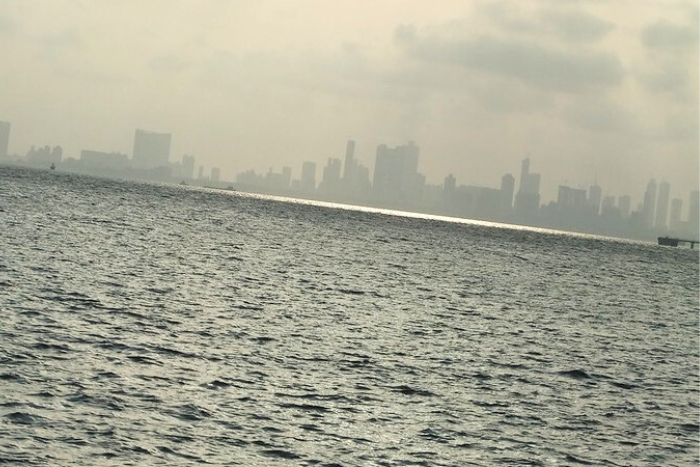A rare triple dip La Nina episode, a phenomenon triggered by climate change, set off a peculiar air quality trend in the 2022-23 winter season in India. The period was characterised by improved air quality in North India and increased pollution levels in Peninsular India, according to the research.
As per the report, Mumbai recorded the highest deterioration with a 30% rise in Particulate Matter (PM) 2.5 levels. It was followed by Coimbatore recording an increase in PM 2.5 levels by 28%, and Bengaluru and Chennai recording a rise of 20% and 12% respectively. “In North India, Ghaziabad recorded the most significant improvement with a reduction of 33%, which was closely followed by Rohtak and Noida with a reduction of 30% and 28%, respectively,”
Ganga water unsafe even for bathing, says Bihar govt report on river pollution
According to the Bihar State Pollution Control Board (BSPCB) almost all major rivers passing through Bihar are unsafe even for bathing, reported HT. The BSPCB survey based on sample checks at 98 points of the rivers, including Ganga, Sone, Kosi and Bagmati, in 27 districts showed excessive presence of faecal coliform bacteria in water. Water sample of Sirasia river at Raxaul yielded presence of around 2,40,000 most probable number (MPN)/100ml. The World Health Organisation (WHO) norms stipulate that river water with more than 1,000MPN/100ml faecal coliform bacteria should not be used even for irrigating crops, as uncooked agricultural produce could make people vulnerable to various kinds of diseases.
According to DTE, the pollution levels stem from release of untreated sewage and contaminated wastewater into rivers, including the Ganga in Patna and other urban areas, the report said. At Gandhi Ghat in Patna, the presence of faecal coliforms was discovered to be 36 times higher than the prescribed criteria. Six sewage treatment plants (STP) installed as part of the highly publicised Namami Gange project are not operating at full capacity. Although the installed STPs have the capacity to treat 350 MLD, the daily discharge in Patna exceeds 700 MLD. The Comptroller and Auditor General (CAG) of India, in its report, highlighted that the treatment capacity of STPs in Patna is insufficient to handle the effluent discharge.
Include ‘super pollutants’ methane and black carbon in NDCs says UNEP chief
The Climate and Clean Air Conference 2024, ahead of the sixth United Nations Environment Assembly (UNEA-6), urged nations to phase-out short-lived climate pollutants, or “super pollutants”, such as methane, black carbon and hydrofluorocarbons. “By addressing short-lived climate pollutants, the world can deliver climate action, improve air quality and human health,” said Inger Andersen, the UNEP’s executive director, in Nairobi, Kenya.
Phasing out super pollutants can reduce air pollution. Protecting crops from pollutants like tropospheric ozone will also boost food security. Global action to reduce black carbon can provide co-benefits of public health protection and climate change mitigation. But stronger global action on air pollution is beginning to eliminate both cooling and warming aerosols and unmasking the warming already committed from high carbon dioxide concentration. This can lead to new heat extremes.
Andersen urged countries to include ‘super pollutants’ such as methane and black carbon in Nationally Determined Contributions (NDC). “Include super pollutants in NDCs as they are being renewed. Finalise methane roadmaps and implement them quickly. And, crucially, find new ways to finance action,” said Andersen. The financing required for methane abatement must increase by a minimum of 3.5 times by 2030, Andersen stated.
CMS COP14: International light pollution guidelines for migratory species announced
The Convention on the Conservation of Migratory Species and Wild Animals (CMS) prepared International Light Pollution Guidelines for migratory species. CMS COP14, which ended in Uzbekistan’s Samarkand noted that natural darkness has conservation value equal to clean water, air and soil, DTE reported. The guidelines say that birds in marine and terrestrial habitats can be affected by lights from as far as 15 km away, causing disorientation, attraction and collision. Birds may starve when artificial lighting disrupts foraging, and fledgling seabirds may not be able to take their first flight if their nesting habitat never becomes dark.
Artificial light can disorient flying migratory birds, diverting from efficient migratory routes or even collide with infrastructure. Migratory shorebirds may avoid roosting sites, which have high proportion of lights and increase their vulnerability to predation due to visibility.
About The Author
You may also like
Air pollution levels lower than Indian norms causing deaths: Study
Air pollution second-biggest reason for deaths among young kids in South Asia: Study
Air pollution leading risk factor for death in South Asia, killed 2.6 million in 2021: Report
Haryana government to launch ₹10,000-crore project to combat air pollution
50% of new cars sold in 2023 globally were polluting SUVs, data shows


